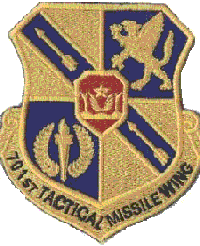|
Sembach AB
Hahn AB
Bitburg AB
Kadena AB
Osan AB
Tainan AB
Lowry AFB
Wheelus AB
Orlando AFB
Camp Happiness
Missile History I
Missile History II
Missile History III
The MM-1
Collectibles
Home Page
|
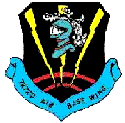 |
Wheelus Air Base, Libya
Home of AMLO
Annual Missile Launch Operations
7382nd Guided Missile Group
701st Tactical Missile Wing
38th Tactical Missile Wing
|
 |
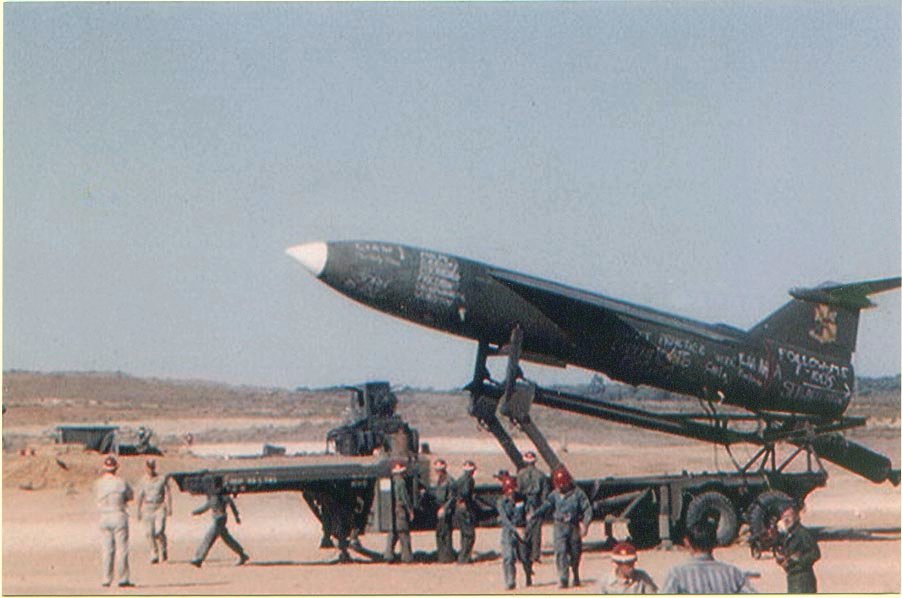
38th TMW Photo courtesy of George Craig
|
|
"Wheelus Air Base, originally known as Mellaha Air Base when it was built by the Italian Air Force in 1923, had been in use by American Air Forces since 1943 when it was used to base American heavy bombers of the Fifteenth Air Force. Later famous as a strategic refueling center for the Strategic Air Command and later a major base for the Military Air Transport Service, Wheelus was made headquarters of the Seventeenth Air Force in 1956 when the Seventeenth AF HQ was relocated from Rabat, Morocco."
The expanse of desert was used first by the 701st TMW, then later its successor, the 38th Tactical Missile Wing, beginning in 1954, with three separate live launch operations for all of the operational squadrons using the Matador. Operations Suntan in October, 1954, Operation Sunburst in June, 1955, and Sunflash in March, 1956, became annual qualification firings for all U.S. Air Force Matador squadrons in Europe.
The missile launch area was located 15 miles east of Tripoli, the remote southern section of the base, away from flight operations. A 1957 article in Aviation Week by Claude Witze stated that 36 Martin Matadors were fired each year at Wheelus by the 701st TMW as part of launch crew training.
Wheelus, with over 27,200 acres, became the U.S. Air Forces Europe Weapons Center in 1959. The bombing and gunnery range was used by USAFE fighter pilots for their annual combat qualifications after missile launch operations were returned to Cape Canaveral in 1959."
© U.S. Air Force Tactical Missiles 1949-1969 The Pioneers, copyright 2008, by George Mindling and Robert Bolton
|

1957
Cape Canaveral launched 13 TM-61C Matadors
Holloman AFB launched 25 TM-61C Matadors.
Wheelus Air Base in Libya launched 36 Matadors,
all operational missiles launched by
Tactical Missile Squadrons stationed in Germany!
|
U.S. Air Force Tactical Missiles
By the Editors of this Website!
|
Beyond the Web Page... The only book devoted exclusively to the Matador and Mace Tactical Missiles. The book reveals the story from the initial idea that became the first U.S. pilotless bomber, through the politically troubled development of the ever evolving deployment methods of the Matador and Mace Tactical Missiles. It covers the Units, Groups, Squadrons and Wing that fielded the missiles. From the United States test sites, Europe, Asia and North Africa nothing is omitted. All phases of the application of these two missiles by the U.S. Air Force (and West German Luftwaffe) are included, from the first tentative launches of the XSSM-A-1 Matador in January 1949, to the tense alert duty of the Cuban Missile Crisis, and the final launch of a MQM13A in May of 1977. The maintenance, logistics and launch, the men, equipment and tactics are all there.
|
|
"Bob, George, I finished your book 2 days after I received it. Couldn't put it down. It was incredible reading and incredibly detailed information."
Kent Washburn (KWASH55@aol.com) Mace B, Kadena, Okinawa
"George and Bob. I want you both to know how much I enjoyed reading and how much I admire and appreciate what you have accomplished in developing and publishing "The Pioneers". It is truly an outstanding piece of work, reflecting the time and effort required to produce it, but is also a formidable contribution to our military history. I mentioned in some earlier correspondence that I was a little disappointed in the relatively small amount of information regarding the Operating Location/Guidance Sites but you largely made up for it with this magnificent book."
Dale Lake (daleflake@yahoo.com) 601st Tactical Control Squadron, 38th TMW, Hamm, Germany
"I just finished your book, The Pioneers, et al. Please accept my "job well done!" Not only is it informative, but it's very readable. I'd also like to complement you on how well you footnoted it. You have shown that a scholarly work can be both instructive and enjoyable."
Michael Roof (lavinaschnur@hotmail.com) SGM USA (Ret.)
|
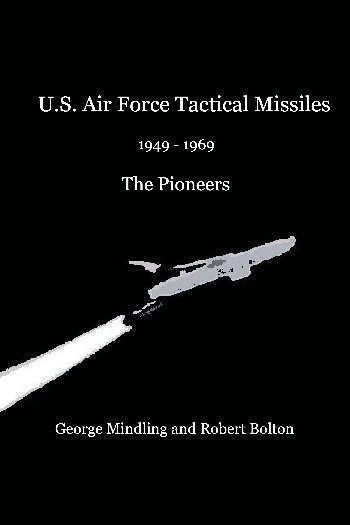
ISBN 978-0-557-00029-6
"Very good work with great detail."
Col. Charlie Simpson, USAF, Retired
Executive Director
Association of Air Force Missileers
"George, the book arrived on Tuesday while I was off to France. Of course, I quickly read the chapter about Germany's quiet step into the realm of nuclear armament. You know, this is still a widely ignored fact over here...
...For me it is fascinating to see what the picture really was in the 1950s and 1960s as opposed to what the official communication of the time wanted people to believe. A fascinating book shedding some light on the early days of tactical nuclear missiles as well as the political background that even today is still largely hidden behind the propaganda of the time. Can't wait to read the rest of it."
Burkhard Domke
Harsefeld, Germany
|
"I have your excellent book on USAF tactical missiles. I actually witnessed the decommissioning of the Maces at Wüscheim back in 1966."
Paul Offen
Talitha, Tye Common Road
Billericay
Essex CM12 9PX
UK
"I just wanted to drop you a line and tell you how much I enjoyed the book that you and Bob wrote. The history was of particluar interest to me and my brother who was a history Professor at the University of Wisconsin. He also thought the book was well written, and he now knows what his little brother, (me), did while in Germany for three years."
George Joseph Snyder (gjsnyder@lanset.com)
71st TMS, Steinborn, Germany
"...by the way, I read your book, it was great, thanks for writing it."
Hack Hunton (hack@sstelco.com) Mace B, Kadena, Okinawa
|
|
US Air Force Tactical Missiles
© 2008 - George Mindling and Robert Bolton |
|
Inspired by the 38th TMW Website, George Mindling and Robert Bolton co-authored US Air Force Tactical Missiles 1949 - 1969: The Pioneers © 2008, the story of America's first operational missiles, from the Matador to the Mace, from Taiwan, Korea, and Okinawa to Germany, including Lowry, Orlando, Holloman, Santa Rosa Island at Eglin, and even Camp Happiness!
|
|
Dieses Buch ist ein Muss für alle, die im Rahmen ihres Dienstes bei der U.S. Air Force mit den frühen Marschflugkörpern
zu tun hatten, aber auch für deutsche Militärarchäologen, die in der Eifel, im Hunsrück oder im Pfälzer Wald schon
über rätselhafte Hinterlassenschaften gestolpert sind. Nach mehr als 40 Jahren wird endlich eine Fälle von Fakten,
Informationen und Geschichten zu den zwischen 1954 und 1969 in Deutschland stationierten, mit Automwaffen ausgerüsteten
amerikanischen Matador und Mace auf den Tisch gelegt.
Ausfährlich und lebendig erzählen George Mindling und Bob Bolton von den jungen Missilemen, die im März 1954 erstmals in Bitburg ankamen -
noch ganz grün im Gesicht, weil auf dem Atlantik schwerer Sturm geherrscht hatte. Von den T-33-Flugzeugen, die aus übungsgründen so taten, als
wären sie Matador-Flugkörper, äber die Startstellungen hinweg in Richtung deutsch-deutsche Grenze donnerten und sich von der Gegenseite
nur nicht erwischen lassen durften. Oder von der Kuba-Krise, als die US Air Force Europe auf DEFCON 3 ging und an die Mechaniker in
Bitburg Munition für ihre Karabiner ausgegeben wurde.
Augenzeugen sagen dazu: "Wir hätten die Vögel auf jeden Fall innerhalb von 15 Minuten in der Luft
haben müssen!" Es ist lebendige Militärgeschichte, die nun nicht der Vergessenheit anheimfällt, sondern
jedermann zugänglich wird - auch für die ortsansässige Bevökerung, die heute endlich erführt, was sich damals
in ihrer Nachbarschaft zugetragen hat. Den beiden Autoren gebührt der Dank.
Klaus Stark (klaus_stark@t-online.de)
Berlin, Germany
This book is not only a must for all those who served in the U.S. Air Force with the early cruise missiles, but also for German military archeologists who have been puzzling over relics stumbled across in the Eifel, the Hunsrück and the Palatinate Forests. After more than 40 years, we finally have a wealth of facts, information and stories, from 1954 to 1969, of the nuclear equipped American Matador and Mace missiles stationed in Germany placed on the table.
With detailed and vivid descriptions, George Mindling and Bob Bolton talk about the young Missilemen who arrived for the first time in March, 1954, in Bitburg - still green in the face, having prevailed the Atlantic crossing in major storm. Of the T-33 aircraft which practiced as if they Matador missiles launched in the direction of German-German border, or from the Cuban missile crisis, when the U.S. Air Force Europe went on DEFCON 3 and was issued ammunition to the mechanics in Bitburg for their rifles. Eyewitnesses say: "We would have to have the birds in the air in any event within 15 minutes!"
It is vital military history that is prey to oblivion, but is now accessible to everyone - even for the local population, which today finally learns what happened at that time in their neighborhood.
The two authors deserve thanks for saving the history.
Klaus Stark,
klaus_stark@t-online.de
Berlin, Germany
|
|

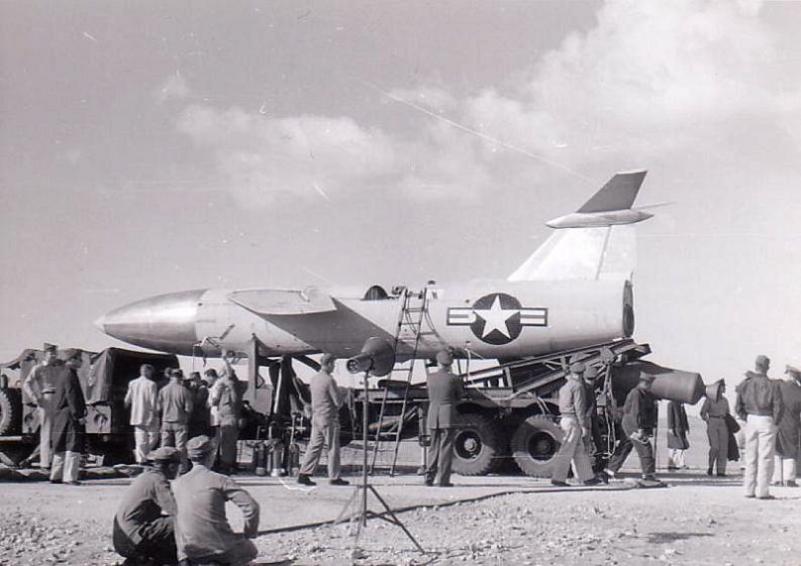
A TM-61C Matador is prepped for launch at Wheelus during Operation Suntan
Photo courtesy of George Craig
|

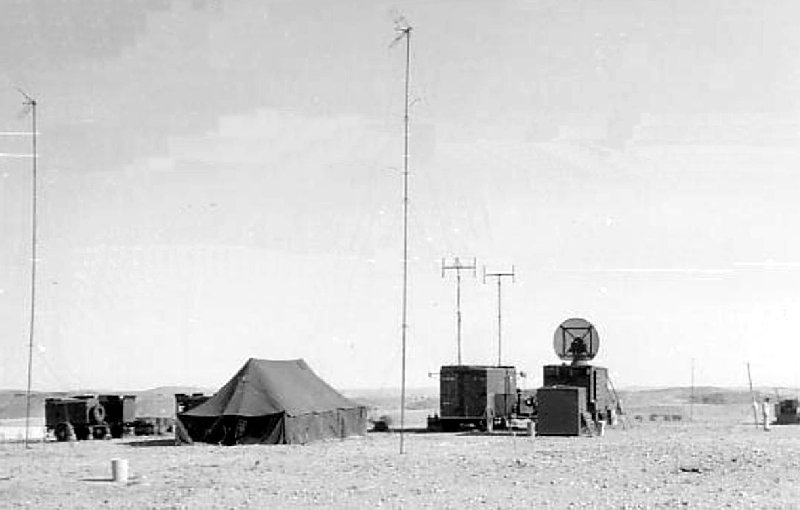
The MSQ-1A radar control site at Garian, Libya, operated during Opertion Suntan by Detachment 3 (Landsberg) of the 585th Communications and Guidance Squadron, Bitburg, Germany
|
|
The chase plane always came to pay us a flyby visit after each mission. One day he came in real low over the desert, up the side of the mountain and right over us. Our two radio antennas were about 60 feet apart. He got very close to them then did a quick 90 degree twist, got thru the antennas then another 90 degree twist, (he's upside down now) after a quarter mile or so he went straight up out of sight. I was locked on to his beacon from about 25 miles out with the MPS-9 radar and followed him all the way in and when he went directly over us the antenna tried its best to follow him. It swung around so fast the van almost tipped over. When he got close I went and stood in the doorway and about fell out on the ground. I never ever tried to follow another one after that when the got too close. Darned Cowboys!
George Craig
1st Pilotless Bomber Squadron, Det #3
Landsburg AB, Germany
|

An F-80 Shooting Star (Still called a P-80 by AF personnel at the time), makes a low level pass over the Garian radar site, 1954.
|
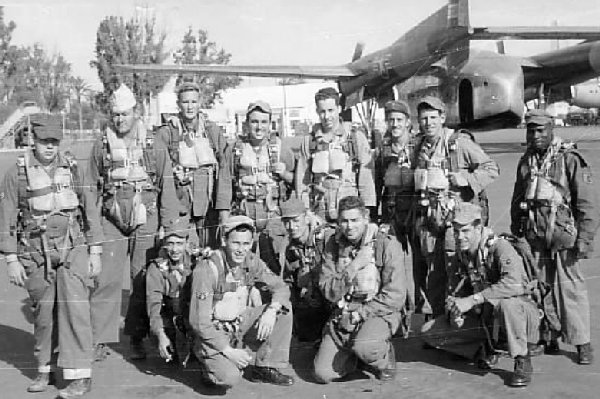
|
"I was part of Det #3 which consisted of 5 radar, 5 radio, 5 air police, 5 power, 3 cooks, 1 supply, 1 orderly room and 4 officers. The plane in the background, a C-119, is the one that took us down. When we took off and got so far down the runway that it was too late to stop, one of the engines sputtered and lost most of its power. We went airborne and swung around and landed going the opposite direction on the same runway. I was sitting up near the front and had the same view as the pilots.
While we were making that turn I happened to glance at this Tech Sergeant sitting right across from me. He was sitting stiff as a board and he was hanging on for dear life and was as white as a sheet. He told me later the same thing happened to him in New Mexico a few years before and he had to bail out. He admitted that he crapped his pants then. He must have been the one who took the picture (above) with my camera.
Anyway, we landed and parked. The pilot sat there gunning the engine for five minutes or so and it cleared up pretty good. So he tried another take-off and all was fine.
We landed in Marseilles, France to refuel before heading to Tripoli. I don't know if this is true or not, but one of the fellows claimed he overheard the pilot asking someone about carburetor parts and they said they had none for our plane. The pilot answered that it was OK and he thought he could make it to Tripoli OK. I guess he was right, I'm here today."
George Craig
1st Pilotless Bomber Squadron, Det #3
Landsburg AB, Germany
|
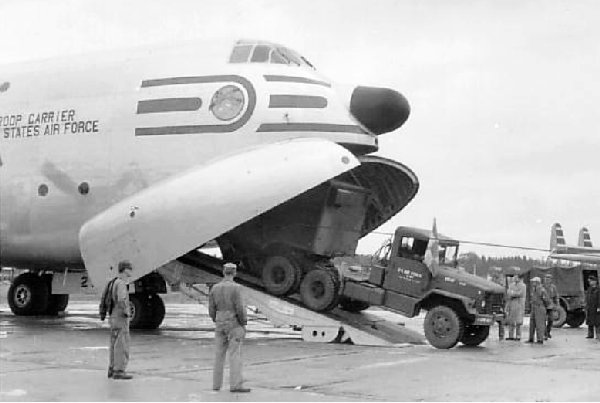
|
|
A radar van of Detachment 3, 585th C&G squadron is loaded aboard a C-124 Globemaster at Furstenfeldbruck AB, near Munich, for the flight to Wheelus Air Base. Libya, for Operation Suntan.
|
Garian and Landsburg Photos Courtesy of George Craig (george8898@hotmail.com) |

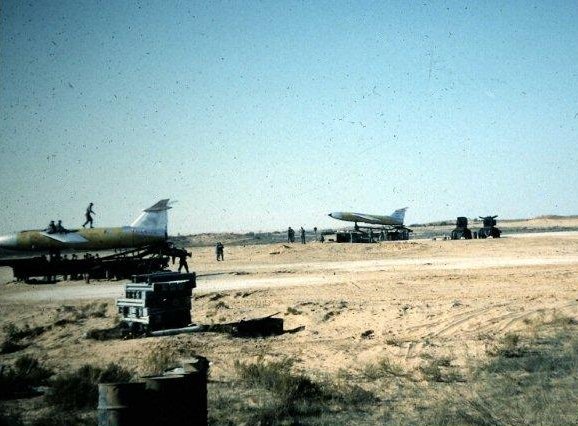
|
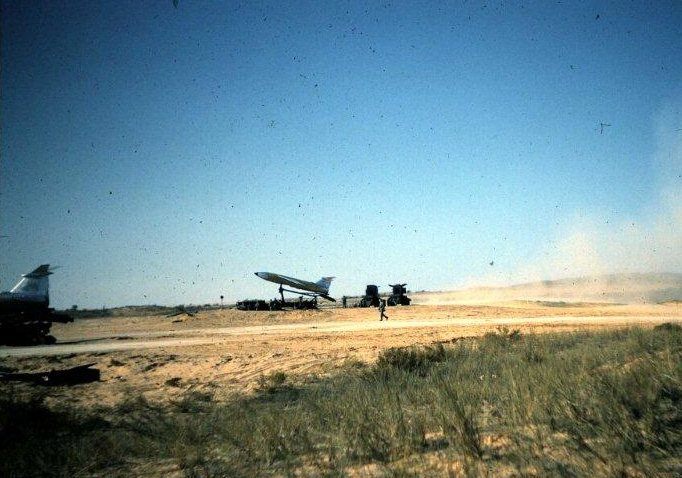
|
"The missile you see ready to take off in the pictures has a story to go with it. When they finally got it launched, they had a problem getting it down. There was an area next to the control van that had loud speakers outside so we could listen to what was going on. When it was time to 'dump' the bird, it would not take the command. We were to be out of the area (impact area) so oil exploration could be done in the afternoon. They talked about sending the bird out over the Med. and letting it run out of gas and go down out there. That was scrubbed, because nobody knew how much fuel was left and they did not want it to come down in a populated area. So a call was made to the base and they scrambled two F-100s to come take the bird down. Some point along the way the pilots were added to the speaker system. The controller was working with the pilots and giving them the location of the bird. He was circling the bird waiting on their arrival. Finally the F-100s got close to the bird, but was having trouble getting behind it, even with their afterburners on. The controller worked with the first one and put the bird going away from the F-100. This F-100 had sidewinder missiles. He shot two at the bird. Then we heard over the radio "Son-of-a-bitch, I missed the bastard." One bounced off the tail and the other off the wing."
|
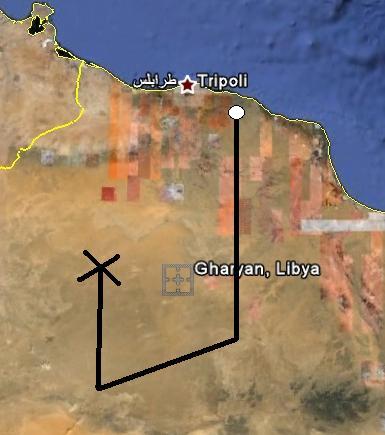
| Left: The normal missile flight path used during the AMLO exercises
Illustration courtesy of George Craig
|
"...Next, the second F-100 comes on the speaker. His mike is hot, just like the first F-100. The controller turns the bird according to his directions and he closes in on the bird. Next we hear the 50 Cals. firing. The next thing we hear from him is that he hit the bird, but it is still climbing and going faster. Light on fuel, it was outrunning the F-100 with its afterburner on. Then the pilot said "I�m bingo fuel, I'm coasting back to base." I heard that soon after that it must have run out of fuel and came down on its own. That was the last I hear about any of it."
Donald Rhodd (drhoddsr@comcast.net)
|

|
|
"...According to the recollections one of the T-33 SimMissile pilots flying this mission to support the AMLO:
...He was too late, the F-100 ran out of fuel and the pilot had to eject. To add insult to injury, the rescue helicopter sent from Wheelus crashed while attempting to pick up the downed F-100 pilot and both aircrews spent the night in the North African desert."
U.S. Air Force Tactical Missiles 1949-1969 The Pioneers, copyright 2008, by George Mindling and Robert Bolton
|

|
“We had our Sidewinder missiles with us over there, and I worked out a deal with the gunnery range commander in Tripoli, where they were firing Matador ground-to-ground missiles that sometimes got away from them. We flew down and chased out of control missiles, hammering them with our Sidewinders - really good practice.”
Maj Gen. Chuck Yeager, USAF, (Retired), then Commander of the 417th Fighter-Bomber Squadron, 50th Fighter-Bomber Wing, (later redesignated the 50th Tactical Fighter Wing) Hahn AB, Germany
Excerpted from Yeager – An Autobiography by General Chuck Yeager and Leo Janos, Bantam Books, July 1985
|

|
"I was at Wheelus field when the missile RATO bottle misfired. Kicked the missile off its cradle, nosed over, nose cone was in the dirt, tail end in the air on the launcher... running at 100%. The RATO bottle sticks had broken in pieces because the crane operator had dropped it. A piece fired every second or so, was scooting all over the ground."
I was there when we lost two checkout vans at the same time. Seems as if the armament lieutenant and the guidance lieutenant were on the outs with each other... the guidance crew called a hold... didn't tell Armament... Armament installed the primercord as they always do, the countdown continued. Guidance checked out the wing destruct system as usual in the countdown, didn't realize the primercord was in place since the two lieutenants weren't speaking... it worked perfectly... wings blew off, caused a fire, all the guys took off out of the vans which caught on fire. The lieutenants did get cussed out.
Randy Mitchell
69th Tactical Missile Squadron
Hahn AB, Germany
|

|
Unfortunately, there were several accidents during the history of the AMLO. The last one was caught with these photographs:
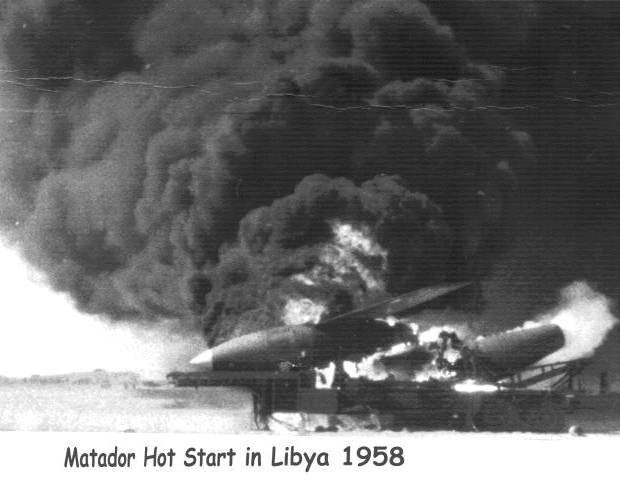
The above photo from the 38th TMW Magazine, The Missileer, 1958, courtesy of
A/1C (tired) Paul A. Yadon, (eatarn1@uswest.net)
|
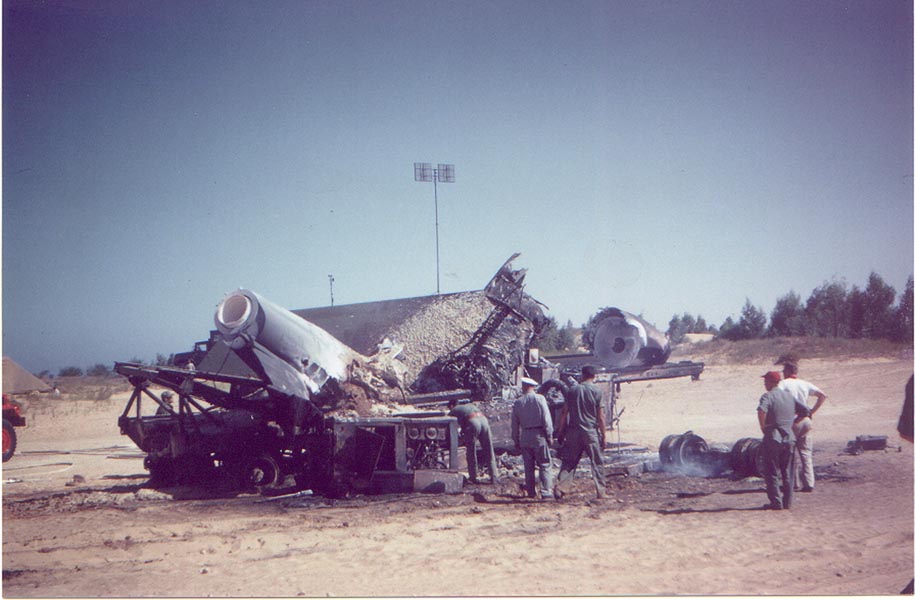
|
|
The 1958 exercise from October 6th through the 19th of November, called "Operation Marblehead," utilized 19 C-130 Hercules and seven C-124 Globemasters just to move the 339 personnel and equipment of the 71st TMS from Bitburg to Wheelus and back. C-47 twin engined transports carried personnel back and forth as well. Not only did the 71st take 13 missiles and the required launchers and checkout vans, but also two complete MSQ units, plus personnel to back up the two Shanicle base units that were permanently installed at Wheelus.
"One staff report from the 71st TMS sent to 38th TMW headquarters after Operation Marblehead about the lack of security and control of the missile flight range, and especially the impact areas, foretold the end of the Wheelus operations. Civilians wandered throughout the missile flight range continuously without regard to Libyan official's warnings and even at times used the warnings as a signal to descend on the known target areas in anticipation of the missiles arrival to collect salvageable debris."
|
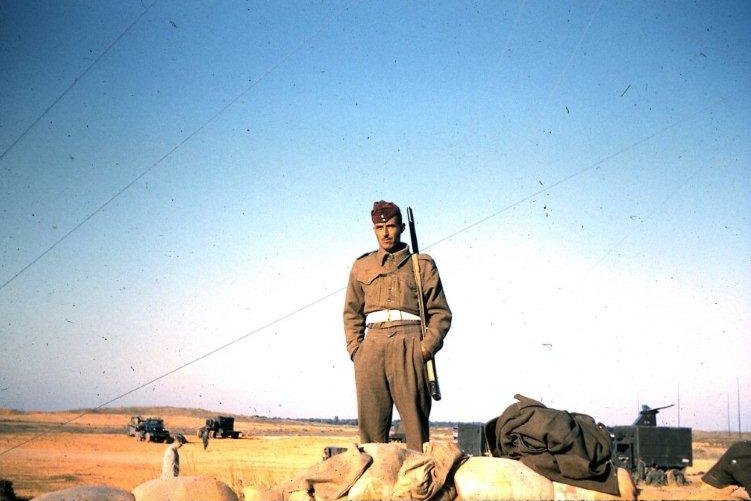
A Libyan Army guard stands watch as missiles are prepped in the background.
Photo courtesy of Donald Rhodd and Charles Martin.
|
"Operation Marblehead in 1958 was indeed the last AMLO at Wheelus. The annual missile live-fire program continued with the tactical missile units selected for the annual certification and training flying back to Orlando AFB in 1959 to launch their missiles from the much more secure Cape Canaveral facilities."
|
![]()
|
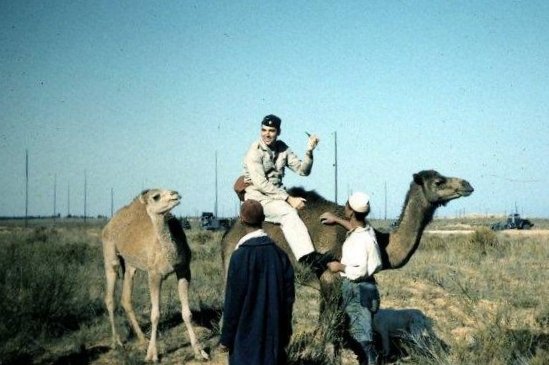
Photo courtesy of Donald Rhodd and Charles Martin.
"I didn't take more pictures because I thought I was the only one with a camera and I did not know if I was allowed to take them or not. The only other person I saw with a camera was the officer who got up on the camel. By the way, he gave the Arab some Camel cigarettes to get on the camel. Don't know who he is."
Donald Rhodd (drhoddsr@comcast.net)
|

![]()
|
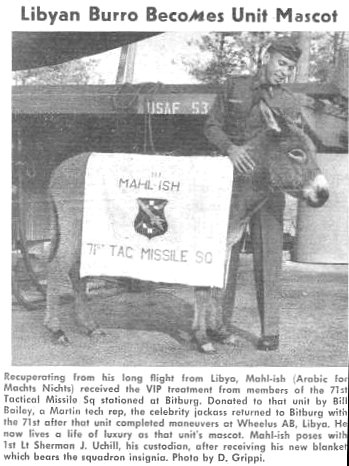
The Perils of Traveling to Libya with Tech Reps.
It is a small, small world! For more on Malish and the 7 year old German farmer's son who ended up taking care of him, check out Ludwig and the Donkey
|

The Webmaster, and I'm sure all Missilemen who ever served in USAF tactical missiles, thanks former Missilemen
George Craig
John Gibbs
Randy Mitchell
Donald Rhodd and
Charles Martin
for their continued support and assistance in maintainting the Wheelus Air Base web page.
|

This page is in no way sponsored or endorsed by the United States Air Force.
Opinions and views expressed are those of the author and not necessarily those of the
Department of the Air Force.
|
All Contributions remain the property of the original owners
All Contributions used with Permission
Web Page Design and Development by
George Mindling - Port Charlotte, Florida
© George Mindling - 2003-2006 All Rights Reserved
|
|
